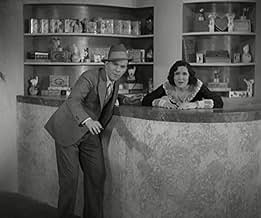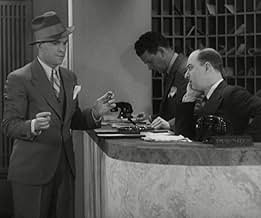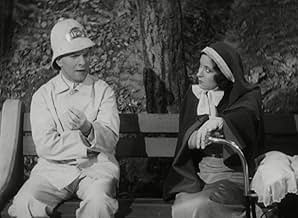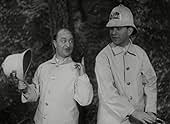George Burns(1896-1996)
- Actor
- Producer
- Writer
George Burns (1896-1996) was an American comedian, actor, singer, and published author. He formed a comedy duo with his wife, Gracie Allen (1895-1964), and typically played the straight man to her zany roles. After her death, Burns started appearing as a solo performer. He once won an Academy Award for Best Supporting Actor in 1975, and continued performing until his 90s. He lived to be 100 years old, and was viewed as an "elder statesman" in the field of comedy.
Burns was born under the name Nathan Birnbaum on January 20, 1896 and was nicknamed "Nattie" by his family. His father was Eliezer "Louis" Birnbaum (1855-1903), a coat presser who also served a substitute cantor at a local synagogue in New York City. His mother was Hadassah "Dorah" Bluth (1857-1927), a homemaker. Both parents were Jewish immigrants, originally from the small town of Kolbuszowa in Austrian Galicia (which is now part of Poland). Kolbuszowa had a large Jewish population until World War II, when the German occupation forces in Poland relocated the local Jews to a ghetto in Rzeszów.
The Birnbaums were a large family, and Burns had 11 siblings. He was the ninth oldest of the Birnbaum children. In 1903, Louis Birnbaum caught influenza and died during an ongoing influenza epidemic. Orphaned when he was 7 years old, Burns had to work to financially support his family. He variously shined shoes, ran errands, sold newspapers, and worked as a syrup maker in a local candy store.
Burns liked to sing while working, and practiced singing harmony with three co-workers of similar age. They were discovered by mail carrier Lou Farley, who gave them the idea to perform singing in exchange for payment. The four children soon started performing as "the Pee-Wee Quartet", singing in brothels, ferry boats, saloons, and street corners. They put their hats down for donations from their audience, though their audience was not always generous. In Burns' own words: "Sometimes the customers threw something in the hats. Sometimes they took something out of the hats. Sometimes they took the hats."
Burns started smoking cigars c. 1910, when he was 14 years old. It became a lifelong habit for him. Burns' performing career was briefly interrupted in 1917 when he was drafted for service in World War I. He eventually failed his physical exams due to his poor eyesight.
By the early 1920s, he adopted the stage name "George Burns", though he told several different versions of why he chose the name. In one version, he supposedly named himself after the then-famous baseball player George Henry Burns (1897-1978), or the also then-famous baseball player George Joseph Burns (1889-1966). In another version, he named himself after his brother, Izzy "George" Birnbaum, and took the last name "Burns" in honor of the Burns Brothers Coal Company.
Burns performed dance routines with various female partners, until he eventually married his most recent partner, Gracie Allen, in 1926. Burns made his film debut in the short comedy film "Lambchops" (1929), which was distributed by Vitaphone. The film simply recorded one of Burns and Allen's comedy routines from vaudeville.
Burns made his feature film debut in a supporting role of the musical comedy "The Big Broadcast" (1932). He appeared regularly in films throughout the 1930s, with his last film role for several years being an appearance in the musical film "Honolulu" (1939). He was reportedly considered for the lead role in the film "Road to Singapore" (1940), but the studio replaced him with Bob Hope (1903-2003) instead.
Burns and Allen started appearing as the comedy relief for a radio show featuring bandleader Guy Lombardo (1902-1977). By February 1932, they received their own sketch comedy radio show. The couple portrayed younger singles until the show was retooled in 1941 and started featuring them as a married couple. By the autumn of 1941, the show had evolved into a situation comedy about their married life. Burns and Allen's supporting cast included notable voice actors Mel Blanc, Bea Benaderet, and Hal March.
The radio show finally ended in 1949 and was reworked into the popular TV show "The George Burns and Gracie Allen Show" (1950-1958). Allen would typically play the "illogically logical" housewife, while Burns played the straight man and often broke the fourth wall to speak to the audience. The couple formed the production company named the McCadden Corporation to help produce the show.
Allen developed heart problems during the 1950s, and by the late 1950s she was unable to put up the energy needed for the show. She fully retired in 1958. The show was briefly reworked again into "The George Burns Show" (1958-1959), but Burns' comedic style at the time was not as popular as that of his wife. The new show was canceled due to low ratings.
Following Allen's death in 1964, Burns attempted a TV comeback by creating the sitcom "Wendy and Me" (1964-1965) about the life of a younger married couple. The lead roles were reserved for Ron Harper and Connie Stevens, while Burns had a supporting role as their landlord. He also performed as the show's narrator.
As a TV producer, Burns produced the military comedies "No Time for Sergeants" (1964-1965) and "Mona McCluskey" (1965-1966). As an actor, he mostly appeared in theaters and night clubs. Burns then had a major career comeback with the comedy film "The Sunshine Boys" (1975), his first film appearance since World War II. He played faded vaudevillian Al Lewis who had a difficult relationship with his former partner, Willy Clark (played by Walter Matthau). The role was met with critical success, and Burns won the Academy Award in that year for Best Supporting Actor. At age 80, Burns was the oldest Oscar winner at the time. His record was broken twice, first by Jessica Tandy in 1990 and then by Christopher Plummer in 2012.
Burns had his greatest film success playing God in the comedy film "Oh, God!" (1977). The film made $51 million dollars at the domestic box office, and was one of the greatest hit films of 1977. He returned to the role in the film's two sequels, "Oh, God! Book II" (1980) and "Oh, God! You Devil" (1984), and had a double role as both God and the devil in the last film of the trilogy.
Burns had several other film roles until the 1990s. His most notable films in this period were the musical-comedy film "Sgt. Pepper's Lonely Hearts Club Band" (1978), the comedy film "Just You and Me, Kid" (1979), the caper film "Going in Style" (1979), and the fantasy-comedy film "18 Again!" (1988). The last of these four films featured him as a grandfather who exchanges souls with his grandson.
Burns' last film role was a bit part in the mystery film "Radioland Murders" (1994), which was a box office flop. In July 1994, Burns slipped and fell in his bathtub and underwent surgery to remove fluid in his skull. He survived, but his health never fully recovered and, as a result, he was forced to retire from both acting and stand-up comedy.
On January 20, 1996 Burns celebrated his 100th birthday, but by then he was in very fragile health and had to cancel a previously arranged comeback performance at the London Pallidium. On March 9, 1996 he suffered from cardiac arrest and died. He was buried at Forest Lawn Memorial Park Cemetery in Glendale, California next to his wife, Gracie Allen. The couple were interred in the cemetery's Freedom Mausoleum at its Sanctuary of Heritage.
Burns was born under the name Nathan Birnbaum on January 20, 1896 and was nicknamed "Nattie" by his family. His father was Eliezer "Louis" Birnbaum (1855-1903), a coat presser who also served a substitute cantor at a local synagogue in New York City. His mother was Hadassah "Dorah" Bluth (1857-1927), a homemaker. Both parents were Jewish immigrants, originally from the small town of Kolbuszowa in Austrian Galicia (which is now part of Poland). Kolbuszowa had a large Jewish population until World War II, when the German occupation forces in Poland relocated the local Jews to a ghetto in Rzeszów.
The Birnbaums were a large family, and Burns had 11 siblings. He was the ninth oldest of the Birnbaum children. In 1903, Louis Birnbaum caught influenza and died during an ongoing influenza epidemic. Orphaned when he was 7 years old, Burns had to work to financially support his family. He variously shined shoes, ran errands, sold newspapers, and worked as a syrup maker in a local candy store.
Burns liked to sing while working, and practiced singing harmony with three co-workers of similar age. They were discovered by mail carrier Lou Farley, who gave them the idea to perform singing in exchange for payment. The four children soon started performing as "the Pee-Wee Quartet", singing in brothels, ferry boats, saloons, and street corners. They put their hats down for donations from their audience, though their audience was not always generous. In Burns' own words: "Sometimes the customers threw something in the hats. Sometimes they took something out of the hats. Sometimes they took the hats."
Burns started smoking cigars c. 1910, when he was 14 years old. It became a lifelong habit for him. Burns' performing career was briefly interrupted in 1917 when he was drafted for service in World War I. He eventually failed his physical exams due to his poor eyesight.
By the early 1920s, he adopted the stage name "George Burns", though he told several different versions of why he chose the name. In one version, he supposedly named himself after the then-famous baseball player George Henry Burns (1897-1978), or the also then-famous baseball player George Joseph Burns (1889-1966). In another version, he named himself after his brother, Izzy "George" Birnbaum, and took the last name "Burns" in honor of the Burns Brothers Coal Company.
Burns performed dance routines with various female partners, until he eventually married his most recent partner, Gracie Allen, in 1926. Burns made his film debut in the short comedy film "Lambchops" (1929), which was distributed by Vitaphone. The film simply recorded one of Burns and Allen's comedy routines from vaudeville.
Burns made his feature film debut in a supporting role of the musical comedy "The Big Broadcast" (1932). He appeared regularly in films throughout the 1930s, with his last film role for several years being an appearance in the musical film "Honolulu" (1939). He was reportedly considered for the lead role in the film "Road to Singapore" (1940), but the studio replaced him with Bob Hope (1903-2003) instead.
Burns and Allen started appearing as the comedy relief for a radio show featuring bandleader Guy Lombardo (1902-1977). By February 1932, they received their own sketch comedy radio show. The couple portrayed younger singles until the show was retooled in 1941 and started featuring them as a married couple. By the autumn of 1941, the show had evolved into a situation comedy about their married life. Burns and Allen's supporting cast included notable voice actors Mel Blanc, Bea Benaderet, and Hal March.
The radio show finally ended in 1949 and was reworked into the popular TV show "The George Burns and Gracie Allen Show" (1950-1958). Allen would typically play the "illogically logical" housewife, while Burns played the straight man and often broke the fourth wall to speak to the audience. The couple formed the production company named the McCadden Corporation to help produce the show.
Allen developed heart problems during the 1950s, and by the late 1950s she was unable to put up the energy needed for the show. She fully retired in 1958. The show was briefly reworked again into "The George Burns Show" (1958-1959), but Burns' comedic style at the time was not as popular as that of his wife. The new show was canceled due to low ratings.
Following Allen's death in 1964, Burns attempted a TV comeback by creating the sitcom "Wendy and Me" (1964-1965) about the life of a younger married couple. The lead roles were reserved for Ron Harper and Connie Stevens, while Burns had a supporting role as their landlord. He also performed as the show's narrator.
As a TV producer, Burns produced the military comedies "No Time for Sergeants" (1964-1965) and "Mona McCluskey" (1965-1966). As an actor, he mostly appeared in theaters and night clubs. Burns then had a major career comeback with the comedy film "The Sunshine Boys" (1975), his first film appearance since World War II. He played faded vaudevillian Al Lewis who had a difficult relationship with his former partner, Willy Clark (played by Walter Matthau). The role was met with critical success, and Burns won the Academy Award in that year for Best Supporting Actor. At age 80, Burns was the oldest Oscar winner at the time. His record was broken twice, first by Jessica Tandy in 1990 and then by Christopher Plummer in 2012.
Burns had his greatest film success playing God in the comedy film "Oh, God!" (1977). The film made $51 million dollars at the domestic box office, and was one of the greatest hit films of 1977. He returned to the role in the film's two sequels, "Oh, God! Book II" (1980) and "Oh, God! You Devil" (1984), and had a double role as both God and the devil in the last film of the trilogy.
Burns had several other film roles until the 1990s. His most notable films in this period were the musical-comedy film "Sgt. Pepper's Lonely Hearts Club Band" (1978), the comedy film "Just You and Me, Kid" (1979), the caper film "Going in Style" (1979), and the fantasy-comedy film "18 Again!" (1988). The last of these four films featured him as a grandfather who exchanges souls with his grandson.
Burns' last film role was a bit part in the mystery film "Radioland Murders" (1994), which was a box office flop. In July 1994, Burns slipped and fell in his bathtub and underwent surgery to remove fluid in his skull. He survived, but his health never fully recovered and, as a result, he was forced to retire from both acting and stand-up comedy.
On January 20, 1996 Burns celebrated his 100th birthday, but by then he was in very fragile health and had to cancel a previously arranged comeback performance at the London Pallidium. On March 9, 1996 he suffered from cardiac arrest and died. He was buried at Forest Lawn Memorial Park Cemetery in Glendale, California next to his wife, Gracie Allen. The couple were interred in the cemetery's Freedom Mausoleum at its Sanctuary of Heritage.














































